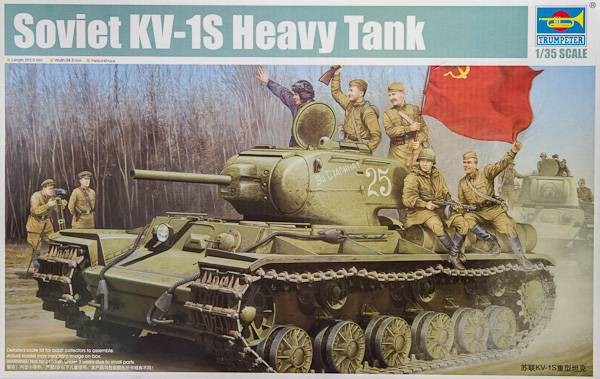
Trumpeter Russian 1/35 KV-1S Heavy Tank
By Eric Christianson
Background
The Kliment Voroshilov (KV) tanks were a series of Soviet Red Army heavy tanks, named after the Soviet defense commissar and politician Kliment Voroshilov. The KV series were known for their extremely heavy armor protection during the early part of World War II, especially during the first year of the invasion of the Soviet Union. Almost completely immune to the 3.7 cm KwK 36 and howitzer-like, short barreled 7.5 cm KwK 37 guns mounted respectively on the early Panzer III and Panzer IV tanks fielded by the invading Nazi forces; until better guns were developed by the Germans it was often the case that the only way to defeat a KV was with a point-blank shot to the rear.
Prior to the invasion, about 500 of the over 22,000 tanks then in Soviet service were of the KV-1 type. When the KV-1 appeared, it outclassed the French Char B1, the only other heavy tank in operational service in the world at that time. Yet in the end it turned out that there was little sense in producing the expensive KV tanks, as the T-34 medium tank performed better (or at least equally) in all practical respects. Later in the war, the KV series became a base of development for the Joseph Stalin (Iosif Stalin, or IS) series of tanks.
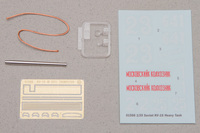 In response to criticism, the lighter KV-1S (Russian language KB-1C) was released, with thinner armor and a smaller, lower turret in order to reclaim some speed. Importantly, the KV-1S also had a commander’s cupola with all-around vision blocks, a first for a Soviet heavy tank. However, the thinning-out of the armor called into question why the tank was being produced at all, when the venerable T-34 could seemingly do everything the KV could do and much more cheaply. A total of 1,370 vehicles were built.
In response to criticism, the lighter KV-1S (Russian language KB-1C) was released, with thinner armor and a smaller, lower turret in order to reclaim some speed. Importantly, the KV-1S also had a commander’s cupola with all-around vision blocks, a first for a Soviet heavy tank. However, the thinning-out of the armor called into question why the tank was being produced at all, when the venerable T-34 could seemingly do everything the KV could do and much more cheaply. A total of 1,370 vehicles were built.
The Kit
 The KV-1S comes in one of Trumpeter's ubiquitous sturdy boxes, containing 11 separately bagged sprues of soft, light grey plastic parts and a separate boxed-in section holding the main tank lower hull and an additional 12 sprues sporting 16 individual track links each.
The KV-1S comes in one of Trumpeter's ubiquitous sturdy boxes, containing 11 separately bagged sprues of soft, light grey plastic parts and a separate boxed-in section holding the main tank lower hull and an additional 12 sprues sporting 16 individual track links each.
There is a small fret of photo-etch as well as markings for five vehicles. An 8-page instruction booklet, a 5-view color sheet, a four-profile color sheet, a promo sleeve showing the kits features in false-negative images, as well and a string for making your own cables round out the contents of the box. Oh yes, and an aluminum barrel is offered as an alternative to a single slide-molded plastic one.
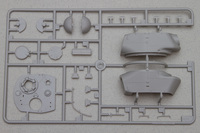 A note here about sprue attachment points. Some companies take care in how parts are molded and attached to the sprues. Unfortunately, Trumpeter isn’t one of them, at least not with this kit. While there are exceptions, most parts have overly thick attachment points, and the points are in places that are either hard to clean or painfully noticeable, requiring either major cleaning or outright replacement in order to produce a show-quality replica.
A note here about sprue attachment points. Some companies take care in how parts are molded and attached to the sprues. Unfortunately, Trumpeter isn’t one of them, at least not with this kit. While there are exceptions, most parts have overly thick attachment points, and the points are in places that are either hard to clean or painfully noticeable, requiring either major cleaning or outright replacement in order to produce a show-quality replica.
Construction
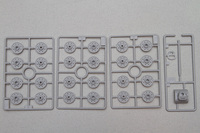 Construction starts with the hull and main running gear. Interestingly, the lower hull comes in three pieces. The main (lower) hull is slide molded as one piece, but contains little surface detail on the sides. That detail is provided via a large, thin slab of plastic that is slapped on each side before the anything else is attached. There is an optional PE replacement for a curved, shelf-like platform that attaches across the rear of the hull, just above the taillight. I cannot figure out what that shelf is for and Trumpeter, as usual, offers no clue in the instructions.
Construction starts with the hull and main running gear. Interestingly, the lower hull comes in three pieces. The main (lower) hull is slide molded as one piece, but contains little surface detail on the sides. That detail is provided via a large, thin slab of plastic that is slapped on each side before the anything else is attached. There is an optional PE replacement for a curved, shelf-like platform that attaches across the rear of the hull, just above the taillight. I cannot figure out what that shelf is for and Trumpeter, as usual, offers no clue in the instructions.
The main engine hatch on the rear deck can be positioned open or closed, although no interior detail is provided save for four large ejection pin marks.
Track
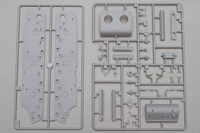 Trumpeter has included link-by-link track with the KV-1S, which comes 16 links to a sprue across 12 sprues. Each link has four relatively heavy attachment points which need to be cleaned thoroughly. Math: 12x16x4 = 768.
Trumpeter has included link-by-link track with the KV-1S, which comes 16 links to a sprue across 12 sprues. Each link has four relatively heavy attachment points which need to be cleaned thoroughly. Math: 12x16x4 = 768.
The good news is that once this task is complete, you are rewarded with beautifully molded links that fit well and look great. This is key to Russian armor, as the track on these vehicles is always right up front and center, pulling in the viewer.
The instructions say to use 88 links per run and they are not ‘sided’, meaning that the links can be assembled for either side of the tank.
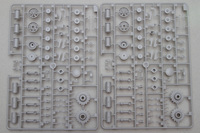 Construction continues along familiar lines. The prominent diesel drums are simple, four-piece affairs that do not have any PE included. The hand rails along the top rear hull are thin and delicate (they came wrapped with special foam packing). The main gun is provided in both aluminum and a single slide-molded plastic piece – nice! String is provided for tow cables but will probably look better if replaced with twisted wire.
Construction continues along familiar lines. The prominent diesel drums are simple, four-piece affairs that do not have any PE included. The hand rails along the top rear hull are thin and delicate (they came wrapped with special foam packing). The main gun is provided in both aluminum and a single slide-molded plastic piece – nice! String is provided for tow cables but will probably look better if replaced with twisted wire.
Conclusion
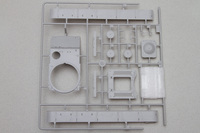 Every collection of Russian World War II armor will have to have a KV-1 in it, and this kit builds into a very nice candidate for that, simply because it represents the final production version. There are not a lot of parts in the kit, which, in my opinion, is just fine for a Russian tank. Rugged, simple, solid. The track detail (once you get it assembled) also appears to be excellent. With a good finish this kit should build up into a nice and unique representation of the real vehicle.
Every collection of Russian World War II armor will have to have a KV-1 in it, and this kit builds into a very nice candidate for that, simply because it represents the final production version. There are not a lot of parts in the kit, which, in my opinion, is just fine for a Russian tank. Rugged, simple, solid. The track detail (once you get it assembled) also appears to be excellent. With a good finish this kit should build up into a nice and unique representation of the real vehicle.
I recommend this kit to anyone who likes to build and finish late war Russian AFV’s. The simplicity of the original vehicle’s design and function translates well into Trumpeter’s release.
I would like to thank Stevens International for providing this kit for review, and to Internet Modeler for giving me the opportunity to review it.
